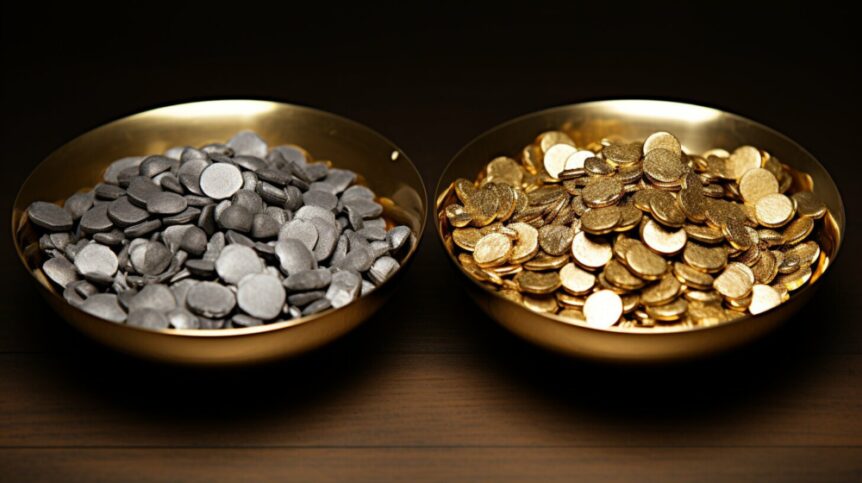Platinum is one of the rarest and most valuable metals in the world, yet it is often cheaper than gold. This may seem counterintuitive, but there are several factors that influence the pricing of these precious metals. In this section, we will explore these factors and provide insights into why platinum is cheaper than gold.
| Key Insights |
|---|
| Platinum is a rare and valuable metal that is often cheaper than gold. |
| The pricing of precious metals is influenced by a variety of factors, including market dynamics, industrial demand, and historical trends. |
| Understanding these factors can help investors make informed decisions about whether to invest in platinum or gold. |
| Despite being cheaper than gold, platinum has significant industrial applications and is a popular choice for jewelry and other luxury goods. |
| Ultimately, the decision to invest in platinum or gold should be based on individual financial goals and market conditions. |
OWNx makes it simple to invest in precious metals.
Understanding Precious Metals
If you’re interested in platinum and gold, it’s important to understand the nature of precious metals. Precious metals refer to naturally occurring metallic elements that are highly valued for their rarity, beauty, and durability. These metals have been used for a range of purposes throughout human history, including jewelry, currency, and industrial applications.
The four major precious metals are gold, silver, platinum, and palladium. Gold is the most well-known and widely used of the precious metals, with a long history of use in jewelry, currency, and investment. Silver is the next most commonly used precious metal, with a wide range of industrial and decorative applications. Platinum and palladium are also used in jewelry and in a variety of industrial processes.
When it comes to jewelry, gold and platinum are the two most popular precious metals. Gold is available in two colors: yellow gold and white gold. Yellow gold is made by mixing pure gold with other metals such as copper and silver. White gold is made by mixing pure gold with other metals such as palladium, nickel, and silver. Platinum, on the other hand, is naturally a white metal, with a bright, shiny appearance that is often compared to white gold.
Gold and platinum are both popular choices for jewelry. While they may look similar, there are some key differences between the two metals. Gold is a softer metal than platinum, which means it is more susceptible to scratches and dents. Platinum is a harder metal and more resistant to damage, making it a popular choice for engagement rings and other frequently worn pieces of jewelry. Platinum is also hypoallergenic, making it a good choice for people with sensitive skin.
Yellow Gold vs. White Gold

As mentioned earlier, gold is available in two colors: yellow gold and white gold. Yellow gold is the traditional color of gold and is often used in classic and traditional jewelry styles. White gold, on the other hand, has a more modern and contemporary look, making it a popular choice for engagement rings and other modern styles of jewelry. White gold is created by mixing pure gold with other metals such as palladium, nickel, and silver, which gives it a bright, silvery appearance.
While both yellow gold and white gold are popular choices for jewelry, they have different properties that make them unique. Yellow gold is a softer metal than white gold, which means it can be more easily scratched or dented. White gold is generally more durable and resistant to damage, making it a good choice for everyday wear.
Platinum Price Over Time
Gold Price Over Time
The Rarity of Platinum
Platinum is a shiny white metal that is rarer than gold. It is found in the Earth’s crust at concentrations of only 5 parts per billion, compared to 0.004 parts per billion for gold. This scarcity contributes to the higher value of platinum compared to other metals.
Platinum is also denser than gold, meaning that a piece of platinum will weigh more than a piece of gold of equivalent size.
Despite its rarity, platinum has several industrial uses. It is a key component in catalytic converters, which reduce harmful emissions from vehicles. The metal’s durability and resistance to corrosion also make it a popular choice in laboratory equipment and electrical contacts.
Overall, the combination of its scarcity and industrial demand contributes to the pricing of platinum in the precious metals market.
Industrial Uses and Demand
Platinum has significant industrial applications, making it one of the most important industrial metals in use today. It is used in the manufacture of various products, ranging from jewelry to electronics, but its most important application is in catalytic converters.
Catalytic converters are essential components in the exhaust systems of automobiles. They reduce the amount of pollution released into the atmosphere by converting harmful gases into less harmful ones. Platinum is a key component in the manufacture of catalytic converters, making it an important part of the automotive industry.
As a result, the demand for platinum from the auto industry has a significant impact on the platinum market. Any changes in the demand for automobiles or in government regulations that govern emissions can affect the price of platinum.
Platinum is also used in the manufacture of other industrial products due to its unique properties. It is a dense, malleable, and ductile metal that is highly resistant to corrosion. These properties make it ideal for use in a wide range of industrial applications.
In terms of color, platinum is a silver colored metal that is often used in jewelry as a substitute for white gold. However, the industrial uses of platinum are far more important than its use in jewelry in terms of its impact on the platinum market.
“Platinum is an important part of the automotive industry due to its use in catalytic converters.”
Historical and Investment Factors
Understanding the historical value of precious metals such as gold and platinum is important when considering their investment potential. The price of gold has been historically stable, and it has been a symbol of wealth for centuries. Physical gold is often seen as a safe haven investment during times of economic crisis or downturn.
On the other hand, platinum’s price fluctuates differently compared to gold. Its industrial uses and demand have a significant impact on its price, making it less stable as an investment option. However, some investors see platinum as an attractive option due to its rarity and potential for higher prices.
It’s important to note that other precious metals such as silver also play a role in the investment market. While not as valuable as gold or platinum, silver’s historic value and industrial uses make it a popular option as well.
Investors should also consider the impact of economic crises and downturns on precious metal prices. During times of uncertainty, gold and platinum prices may rise due to their perceived material value and stability in the market.
Learn more about Precious Metal IRAs
While investment in precious metals may be appealing for some, it’s important to weigh all options and consider their role in a diversified portfolio. Traditional stocks and other investment options should also be considered when planning for the future.
OWNx makes it simple to invest in precious metals.
Market Dynamics and Price Differences
Platinum prices have fluctuated differently compared to gold prices over the years, making it an affordable option for investors. The price of platinum is affected by a variety of market dynamics, including supply and demand, economic conditions, and geopolitical events, among others.
The price of platinum is also affected by the price of gold, as both precious metals are often compared to one another. Currently, platinum is cheaper than gold due to a combination of factors, including its industrial uses and historical factors.
| Price Differences | Reasons |
| Platinum cheaper than gold | Industrial demand for platinum in the automobile industry, among others, has a significant impact on the price of platinum, making it more affordable than gold despite its rarity. |
| Price of platinum fluctuates differently compared to gold | While gold is considered a more stable investment option, platinum prices tend to fluctuate more due to its industrial uses and market dynamics. |
In recent years, platinum prices have been affected by the rise of electric vehicles, as they do not require catalytic converters, the primary industrial use for platinum. However, demand for platinum for other industrial uses, such as in the healthcare industry and in electronic devices, has remained strong.
Overall, the price differences between platinum and gold are influenced by a variety of factors, including market dynamics, historic value, and industrial uses. It’s important for investors to consider these factors and the unique characteristics of both metals when making investment decisions.
Investors often consider both platinum and gold as potential investments due to their material value, stability in the market, and their role in diversified portfolios and retirement savings. When buying precious metals, it’s essential to understand the weight and purity of the metal, which is measured in troy ounces.

| Factors | Potential Impact on Platinum Prices |
| Demand for Electric Vehicles | Increase in demand for platinum in fuel cell technologies |
| Utilization in Fuel Cell Technologies | Potential growth in platinum demand across various industries |
| Supply Disruptions | Possible decrease in platinum supply and higher prices |
Platinum options include buying physical platinum, platinum ETFs, or purchasing platinum futures. However, buying physical platinum requires a higher investment due to its higher price per troy ounce than gold. For traditional stocks, investing in mining companies or mutual funds that own precious metals is an option, but it’s essential to research these options thoroughly to ensure they align with your investment strategy.
Gold is often considered the gold standard of investments due to its steady returns and historical value. It’s also a popular choice for retirement savings because it’s a tangible asset that can be stored and sold at any time. Gold prices tend to fluctuate less than platinum prices, making it a more stable investment option for some investors.
When compared to gold, platinum’s price has historically been more volatile, but it can offer higher returns over time. Investing in platinum offers a way to diversify a portfolio and hedge against inflation. However, it’s important to do your research and monitor market trends to make informed investment decisions.
It’s essential to consider your financial goals, investment strategy, and risk tolerance before investing in any precious metals. Platinum and gold both offer unique benefits and drawbacks, and it’s important to weigh these factors before deciding which metal to invest in.
Industrial and Financial Outlook
The auto industry has a significant impact on the prices of platinum and gold. Platinum is widely used in catalytic converters, making it a crucial component in reducing emissions from vehicles. As the auto industry shifts towards more eco-friendly technologies, such as electric vehicles, the demand for platinum may decrease, resulting in a decrease in its price.
Platinum and gold hold a special place in the hearts of the most well-informed investors. Despite being a less popular investment option than traditional stocks, many investors consider them as a safe haven during times of economic uncertainty. As a result, they tend to hold their value well during economic downturns, making them a valuable addition to diversified portfolios.
Some credit card companies even offer platinum credit cards for high net worth customers, highlighting the precious metal’s association with wealth and luxury.
The global economy also has a significant impact on the prices of platinum and gold. As the world becomes more interconnected, economic crises in one region can affect the prices of precious metals worldwide. In times of global instability, investors may seek to invest in precious metals as a hedge against inflation and other economic risks. This increased demand can lead to higher prices for both platinum and gold.
Overall, the industrial and financial outlook for platinum and gold is complex and multifaceted. However, their unique characteristics and uses make them intriguing options for investors looking to diversify their portfolios and protect their retirement savings.
While platinum and gold are both precious metals, they have distinct differences that make them unique assets. Despite being rare metals that are often used in jewelry, they have different industrial uses and play different roles in the financial system.
One key difference between platinum and gold is their industrial uses. While gold is primarily used in jewelry and as a store of value, platinum has significant industrial applications. Platinum is a crucial component in catalytic converters, making it an essential metal in the automobile industry. Additionally, platinum is used in electronics, medical equipment, and other industrial applications, giving it a broader range of industrial uses than gold.
Another difference between the two metals is their role in the financial system. Gold has long been recognized as a store of value and a hedge against inflation, making it a popular investment choice. Platinum, on the other hand, has a smaller role in the financial system and is not widely recognized as a store of value. This difference in perception has resulted in different price trends for the two metals.
While platinum and gold are both considered precious metals, they are part of a broader category of metals that includes silver and palladium. These metals have different characteristics and uses, making them distinct assets within the metals market.
Overall, the key differences between platinum and gold lie in their industrial uses and their role in the financial system. While they are both valuable metals with unique properties, the factors that set them apart make them distinct assets for investors to consider.
Conclusion
Investors have a lot to consider when choosing between investing in platinum or gold. While platinum is rarer than gold, its price is generally cheaper due to market dynamics, industrial demand, and historical factors. The price of platinum also fluctuates differently compared to gold, making it an intriguing option for investors. It’s important to consider the unique characteristics and uses of platinum and gold when making investment decisions. Platinum has significant industrial applications, particularly in the automobile industry where it is used in catalytic converters. Meanwhile, gold is often used in jewelry and is considered a safe-haven asset in times of economic uncertainty. Investing in precious metals can be a wise move in diversifying your investment portfolio, but it’s important to understand the risks and benefits of each metal. While some investors prefer traditional stocks or the gold standard, platinum options are also worth considering. As the global economy continues to evolve, the prices of platinum, gold, and silver may also fluctuate. However, by understanding the key differences between these metals and evaluating their industrial and financial outlook, investors can make informed decisions about their investment strategies. In the end, whether you choose to buy platinum, gold, or silver, remember to always consult with a financial advisor and do your own research to make the best decision for your retirement savings and investment goals.
OWNx makes it simple to invest in precious metals.
FAQ
Platinum is generally cheaper than gold due to market dynamics, industrial demand, and historical factors that influence its price. Despite being rarer than gold, platinum’s price fluctuates differently, making it a more affordable precious metal.
Platinum and gold have key differences beyond their price. Platinum has significant industrial uses, particularly in the auto industry, while gold is often associated with its historic value and role in the financial system. These differences set them apart as metals.
Industrial demand, especially in the automobile industry where platinum is used in catalytic converters, has a significant impact on the price of platinum. The demand for platinum in industrial applications can affect its prices compared to other precious metals.
Historical factors, such as economic crises and downturns, can influence the prices of platinum and gold. Gold is often considered a safe-haven investment during uncertain times, which can affect its price compared to platinum.
Both platinum and gold are considered potential investments. Investors often evaluate their stability in the market, material value, and their role in diversified portfolios and retirement savings when comparing platinum and gold as investment options.
